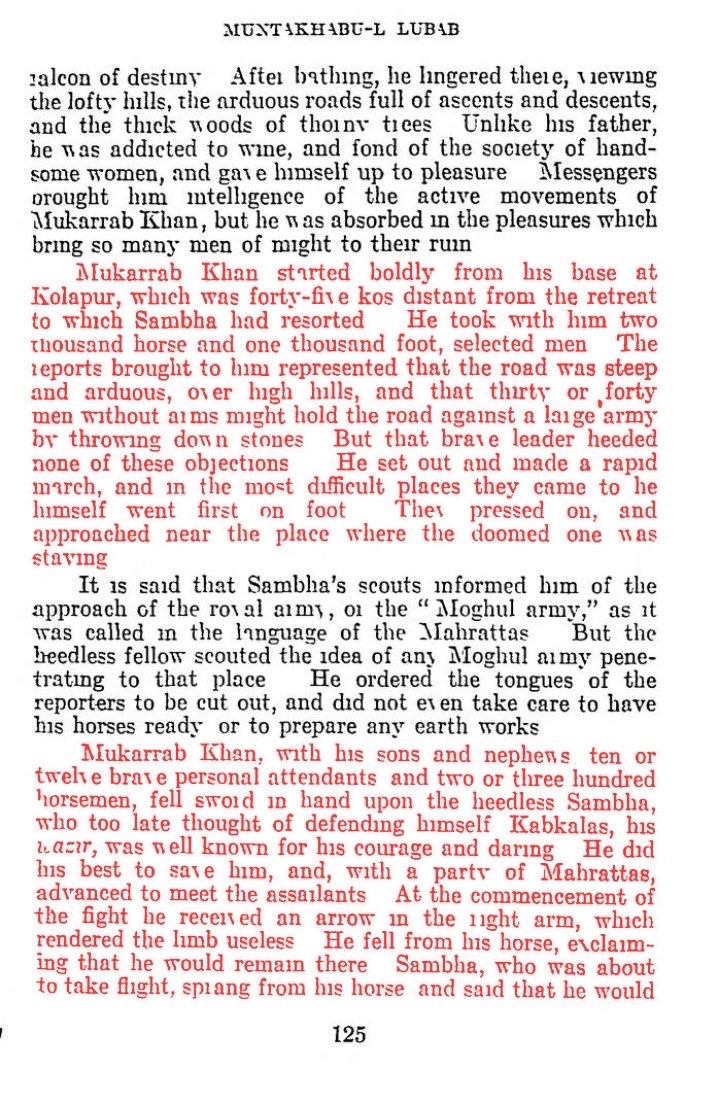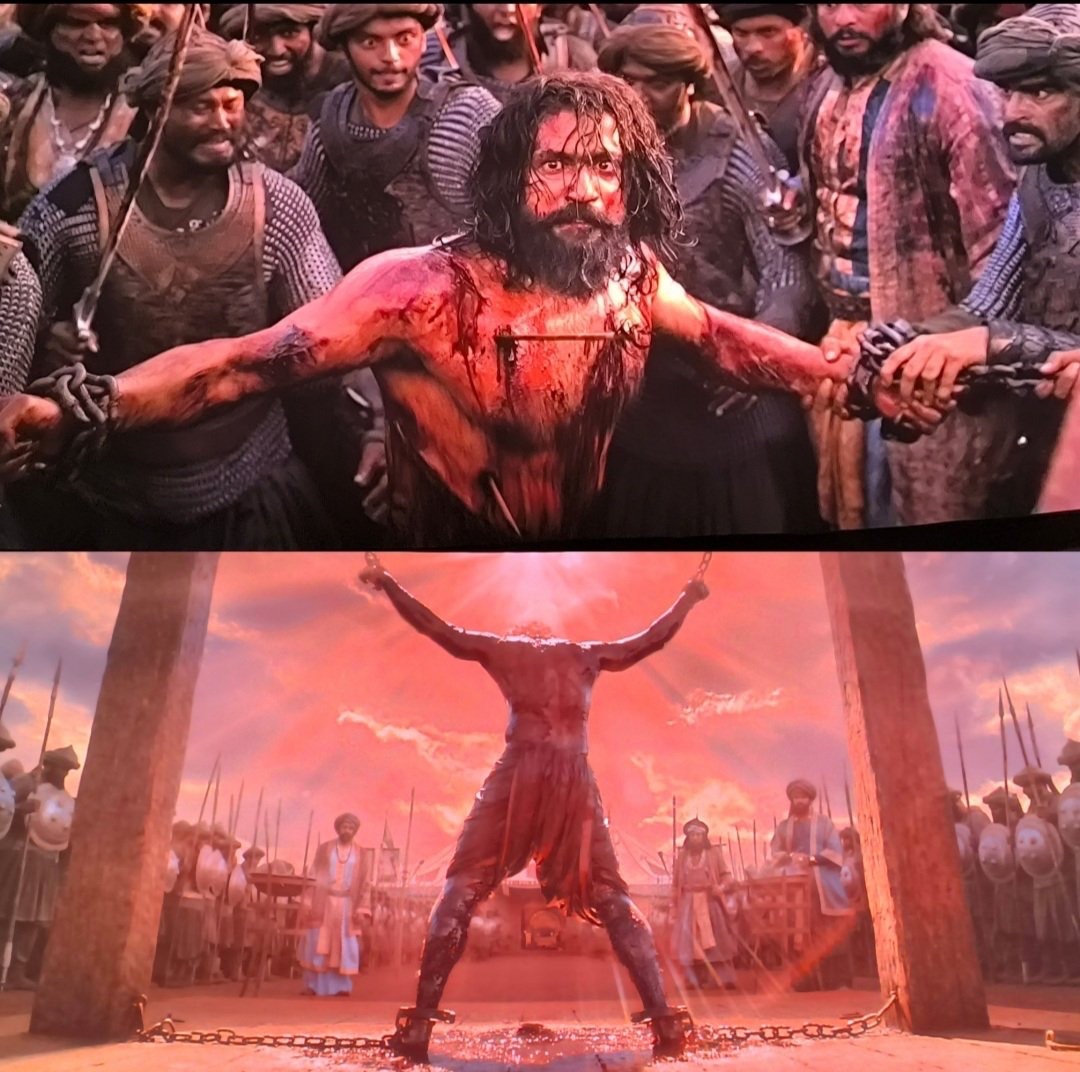The movie Chhava moved many to tears with its depiction of Chhatrapati Sambhaji Maharaj’s torture. However, his real suffering was far more brutal and horrific than what what was shown in the film
The TRUE story of Sambhaji’s BRUTAL execution 🧵
The TRUE story of Sambhaji’s BRUTAL execution 🧵

In early 1689, Sambhaji was in Sangameshwar with his trusted advisor, Kavi Kalash. A local informer betrayed his location to the Mughals.
Muqarrab Khan, a Mughal commander, launched a sudden ambush with overwhelming numbers. Sambhaji fought back but was eventually captured.


Muqarrab Khan, a Mughal commander, launched a sudden ambush with overwhelming numbers. Sambhaji fought back but was eventually captured.



Along with him, 25 of his loyal followers and their families were taken prisoner. Their hands and feet were manacled, their bodies chained.
Even before reaching Aurangzeb’s court, their humiliation had begun. The once-mighty Maratha king was now a captive, paraded in disgrace.
Even before reaching Aurangzeb’s court, their humiliation had begun. The once-mighty Maratha king was now a captive, paraded in disgrace.

Aurangzeb wanted more than just Sambhaji’s death. He wanted to break him publicly, to humiliate him so completely that no Hindu king would ever dare to challenge the Mughal throne again.
To achieve this, he orchestrated a gruesome spectacle.
To achieve this, he orchestrated a gruesome spectacle.

The Mughals turned his suffering into a celebration. Drums & trumpets blared, the camp was lit up & the Muslim army rejoiced all night.
This was no mere victory procession. It was a sadistic display designed to celebrate the “triumph of Islam.”

This was no mere victory procession. It was a sadistic display designed to celebrate the “triumph of Islam.”


The entire night before Sambhaji was presented to Aurangzeb was one of celebration. The shab-i-barat (night of forgiveness) was observed, but for a different purpose.
No one slept, for they all wanted to witness the humiliation of the great Maratha king.
No one slept, for they all wanted to witness the humiliation of the great Maratha king.

When Sambhaji reached Aurangzeb’s court, the emperor himself was so overcome with joy that he fell to his knees in prayer.
For him, this was not just a military triumph but an ideological victory—a moment where, in his eyes, Islam had triumphed over the infidels of the Deccan.

For him, this was not just a military triumph but an ideological victory—a moment where, in his eyes, Islam had triumphed over the infidels of the Deccan.


Aurangzeb wanted Sambhaji to repent for his actions by converting to Islam. He offered him riches, power & even freedom in exchange for his submission.
But Sambhaji remained defiant. He spat at the offer and refused to speak a word. His silence only deepened the emperor’s rage.
But Sambhaji remained defiant. He spat at the offer and refused to speak a word. His silence only deepened the emperor’s rage.

For Aurangzeb, this was personal. Sambhaji had humiliated him before, slipping from his grasp in the past & now, he had the audacity to defy him once more.
With the Maratha king finally in his clutches, Aurangzeb was determined to exact the most brutal revenge imaginable.
With the Maratha king finally in his clutches, Aurangzeb was determined to exact the most brutal revenge imaginable.

The torture began immediately. Sambhaji’s eyes were gouged out. Kavi Kalash’s tongue was pulled out with iron pincers, ensuring he could never speak again.
His nails were ripped off, his skin was flayed & his wounds were soaked with salt so as to intensify the pain.

His nails were ripped off, his skin was flayed & his wounds were soaked with salt so as to intensify the pain.


Even in this state, he refused to convert or beg for mercy. Kavi Kalash was subjected to the same fate. Both were beaten, whipped & burned w/hot iron rods.
The tortures were not random—they were designed to prolong suffering while keeping them alive, breaking them inch by inch.


The tortures were not random—they were designed to prolong suffering while keeping them alive, breaking them inch by inch.



Aurangzeb did not stop at torturing Sambhaji alone. His entire family was imprisoned, many of them subjected to torment.
His captors, who had betrayed him for the Mughals, were richly rewarded with land, money, and high ranks in the Mughal administration.
His captors, who had betrayed him for the Mughals, were richly rewarded with land, money, and high ranks in the Mughal administration.

For two weeks, the torture continued. One of the most horrific methods used was tying them to wheels placed over burning fires, roasting them alive while the Mughal soldiers watched.
Even then, neither Sambhaji nor Kavi Kalash revealed any secrets about Maratha wealth or plans.
Even then, neither Sambhaji nor Kavi Kalash revealed any secrets about Maratha wealth or plans.

Aurangzeb had expected Sambhaji to break—to beg, to convert, to submit. But despite suffering unimaginable pain, Sambhaji never relented.
His silence in the face of such extreme brutality became an act of defiance, turning him into a symbol of resistance.
His silence in the face of such extreme brutality became an act of defiance, turning him into a symbol of resistance.

Finally, after two weeks of torture, Aurangzeb decided to put on a show trial in his Sharia court.
Sambhaji was accused of slaying Muslims, imprisoning Mughal officials, and plundering Islamic cities.
The verdict was predetermined—execution by beheading.

Sambhaji was accused of slaying Muslims, imprisoning Mughal officials, and plundering Islamic cities.
The verdict was predetermined—execution by beheading.


On March 11, 1689, Sambhaji and Kavi Kalash were taken to the banks of the Bhima River, 15 miles from Pune.
Here, the final act of Aurangzeb’s vengeance was carried out. But even in death, the cruelty did not cease.
Here, the final act of Aurangzeb’s vengeance was carried out. But even in death, the cruelty did not cease.

Sambhaji was not simply beheaded. He was hacked to pieces, limb by limb, his body torn apart while still alive.
Some accounts state that he was ripped apart using Wagh Nakhe (Tiger Claws).
His suffering was prolonged, ensuring he experienced every moment of agony.

Some accounts state that he was ripped apart using Wagh Nakhe (Tiger Claws).
His suffering was prolonged, ensuring he experienced every moment of agony.


Kavi Kalash met the same fate. Their bodies were left uncremated, their flesh and bones abandoned as food for vultures.
This was a calculated move by Aurangzeb—denying them funeral rites was meant to strip them of dignity even in death.
This was a calculated move by Aurangzeb—denying them funeral rites was meant to strip them of dignity even in death.

But Aurangzeb’s cruelty went further. The heads of Sambhaji and Kavi Kalash were stuffed with straw and mounted on poles.
These grotesque trophies were paraded through major cities in the Deccan, meant to instill fear in the hearts of the Marathas.

These grotesque trophies were paraded through major cities in the Deccan, meant to instill fear in the hearts of the Marathas.


Tens of thousands of people witnessed these grim processions. Some wept silently. Others clenched their fists in rage. But none dared to resist—for now.
The Mughals believed they had crushed the Maratha spirit. They could not have been more wrong.
The Mughals believed they had crushed the Maratha spirit. They could not have been more wrong.

Sambhaji’s death did not end the Marathas. It ignited them.
Sambhaji’s brother Rajaram took charge, and the Marathas launched a relentless guerrilla war.
Their descendants later continued the resistance, turning the tables on Aurangzeb’s grand ambitions.
Sambhaji’s brother Rajaram took charge, and the Marathas launched a relentless guerrilla war.
Their descendants later continued the resistance, turning the tables on Aurangzeb’s grand ambitions.

Aurangzeb had hoped that Sambhaji’s death would crush the Maratha resistance.
Instead, it ignited an unrelenting war that drained the Mughal treasury, shattered their hold over the Deccan, and ultimately led to the empire’s downfall.
Instead, it ignited an unrelenting war that drained the Mughal treasury, shattered their hold over the Deccan, and ultimately led to the empire’s downfall.

In 1707, Aurangzeb died, a broken and exhausted man. Just a few decades later, the Marathas would rise to become the dominant power in India, pushing the Mughals into irrelevance.
Chhatrapati Sambhaji’s death had not been in vain.
Chhatrapati Sambhaji’s death had not been in vain.

Today, Sambhaji Maharaj is remembered not for how he was captured or killed, but for how he lived and died—undaunted, unbroken, and unyielding in the face of unimaginable cruelty.
His sacrifice ensured that the flag of Swarajya would continue to fly high.
His sacrifice ensured that the flag of Swarajya would continue to fly high.

Sambhaji Raje’s capture, torture & execution at the hands of Aurangzeb is one of the most brutal yet defining moments in Indian history.
His story is one of honour & courage. A reminder that tyranny, no matter how powerful, can never crush the spirit of those who refuse to bow.
His story is one of honour & courage. A reminder that tyranny, no matter how powerful, can never crush the spirit of those who refuse to bow.

That's a wrap! If you enjoyed this thread:
1. Follow me @CultChron for more of these informative threads.
2. Retweet the thread to spread the word!
3. Check out our Substack page here: cultchron.substack.com
Until then, goodbye!
x.com/CultChron/stat…
1. Follow me @CultChron for more of these informative threads.
2. Retweet the thread to spread the word!
3. Check out our Substack page here: cultchron.substack.com
Until then, goodbye!
x.com/CultChron/stat…
Don’t miss out on more such insightful content. Subscribe to our YouTube channel here (high quality videos will soon be published there)! ⬇️
youtube.com/shorts/4MhL9rG…
youtube.com/shorts/4MhL9rG…
• • •
Missing some Tweet in this thread? You can try to
force a refresh

































